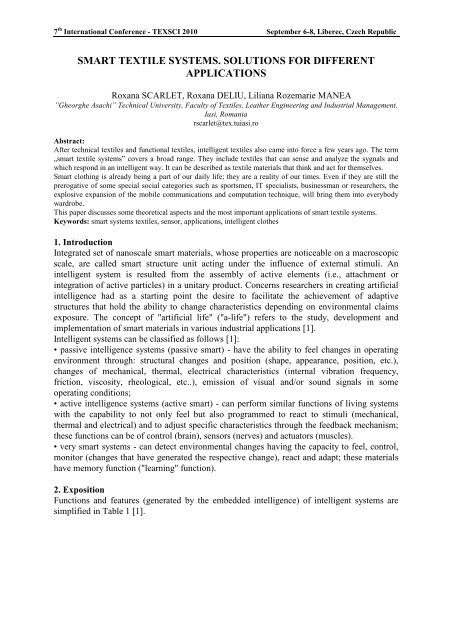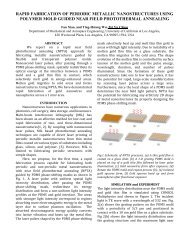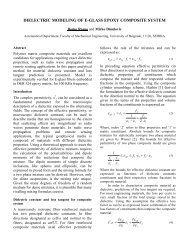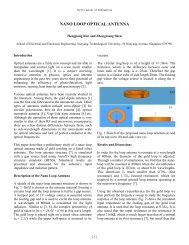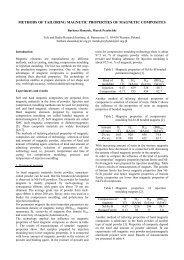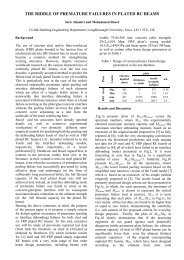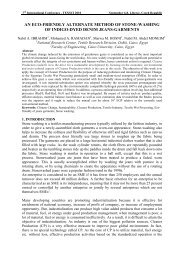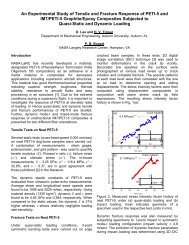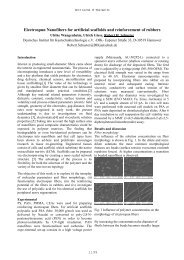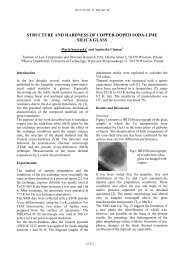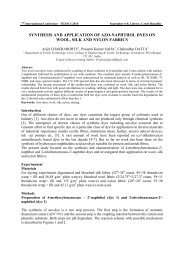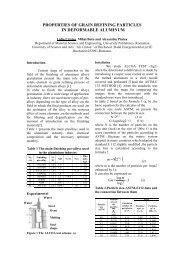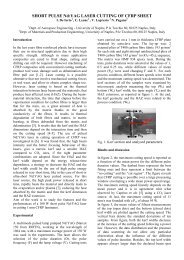smart textile systems. solutions for different applications
smart textile systems. solutions for different applications
smart textile systems. solutions for different applications
You also want an ePaper? Increase the reach of your titles
YUMPU automatically turns print PDFs into web optimized ePapers that Google loves.
7 th International Conference - TEXSCI 2010 September 6-8, Liberec, Czech RepublicTable 1. Functions of Intelligent SystemsNr. Function Definition / general characteristics1. sensors(nerves)Sensors define the so-called "captive" (sensory materials) andrepresent detection <strong>systems</strong> that translate changes detected in theenvironmental in signals describing the state of structure, namely the2. actuators(muscles)3. control(brain)material system.Actuators define so-called "action elements", "reactive" materials or"adaptive" (which are "educated"), are able to carry out actions strictlymechanical, change certain structural-design characteristics (shape,appearance, position, etc.), mechanical (rigidity, vibration frequency,friction, viscosity), in response to <strong>different</strong> types of changes: heating,electrical, magnetic, damping capacity, etc.).-define the so-called "neural networks" or transfer devices whichfulfilling the role in ensuring the complex communication (signalprocessing, memory, control of these reactions); - functionalarchitecture incorporated in such a system includes a complexorganizational system through a global or local hierarchy, so eachin<strong>for</strong>mation is processed at a level of complexity appropriate to itsimportance; - to fulfil the following functions: signal processing,ranking of the signals after their importance and/or precision,memory, signal evaluation, control response to the received signal.4. learning - specific to very intelligent <strong>systems</strong> that have the ability to detect,react, change, control and monitor changes in a parameter and togenerate optimal responses to changes in the operation.These intelligent <strong>systems</strong> require a highly specialized, interdisciplinary background covering arange of research aimed at holding up the top technique in various fields. The usage domainsof these <strong>smart</strong> materials and <strong>systems</strong> are wide, the most interesting and recent <strong>applications</strong>from the <strong>textile</strong> industry are presented in Table 2 [1, 2].Tabel 2. Smart <strong>systems</strong> <strong>applications</strong> in <strong>textile</strong> industryCommercial name / companyObservationsClothing with medical <strong>applications</strong>Intelligent medical clothing have the potential to substantially change the health care services<strong>for</strong> example <strong>for</strong> those who suffer of chronic diseases (such as diabetes, cardiovascular,respiratory disorders) and the elderly with specific needs. When are embedded into theclothing, the technology could monitor the wearer's heart rate, temperature, respiration, bloodpressure, per<strong>for</strong>m an ECG and other vital functions, alerting the wearer or physician if thereis a problem. Developments in telecommunication and computers are the main technicaltools <strong>for</strong> Telemedicine (Telecare, Telehealth). Telemedicine represents the possibility to stayin contact with their physician or health care provider <strong>for</strong> some medical advices, to be alertedif something goes wrong with their health. All these are new possibilities <strong>for</strong> personalizedhealth care.- it is a modular autonomous recorder system <strong>for</strong> themeasurement of the autonomic nervous system activity [3];- it is a hybrid device associating the advantages and thespecificity of the <strong>smart</strong> clothes and of the wrist devices;- it has 6 hours autonomy at full utilization.- the MARSIAN <strong>smart</strong> glove has a specific design to ensure
7 th International Conference - TEXSCI 2010 September 6-8, Liberec, Czech RepublicMARSIAN – a modularautonomous recordersystem <strong>for</strong> measurementof autonomic nervoussystem activityDEPIC - Early Detectionof Cutaneous Infection inPeritoneal DialysisMini Fetal MonitorMELODIE – aprogrammable andportable pumpVTAMNboth a good contact from skin to electrodes whatever the handmotion will be and a correct furtivity of the glove so as not tomodify the typical physiology of the hand skin;- it ensures real-time physiological data aquisition, treatmentand wireless transmission in a minimum size.- is a portable device, autonomous, usable in hospital, but alsoat home [6]; the device developed a non-invasive sensoranalyzing the cutaneous thermal parameters around thepermanent catheter used <strong>for</strong> peritoneal dialysis and can behandled by the patient at home;- uses a flexible technology <strong>for</strong> the membrane and 20 sensors<strong>for</strong> the mapping of the skin thermal parameters;- the device is connected to “DIALETIC” system oftelemonitoring of dialysis at home which analyzes the data todetect alarm signals and to prevent aggravations; if an alarmoccurs, the system in<strong>for</strong>ms the nephrologists, the patient and thetreating general practitioner;- allows the diagnosis of an infection be<strong>for</strong>e the appearance ofcomplications and can alert the patient and the physician intime.- a fetal monitoring device that tracks a baby's position andmovement in the womb, as well as baby and mother heart rates;the device is capable of collecting data <strong>for</strong> up to 24 hours and isportable and wearable, about the size of a mobile phone [6];- five electrodes placed on the mother's belly pick up electricalsignals just like an EKG <strong>for</strong> heart monitoring; the monitorstores the in<strong>for</strong>mation on a USB device that doctors can readoff any computer; the monitor can spot danger signs earlier,giving doctors time to intervene and help save lives.- allows the physician to program the frequency and timing ofadministration of drugs, in exact accordance with the prescribedregimen;- it ensures all the basic requirements <strong>for</strong> monitoring treatmentby producing two documents <strong>for</strong> inclusion in the patient’smedical records. While the protocol is being set up, a programreport is produced which ensures that the infusion can bechecked at a later stage. Similarly, at the end of the treatment,an infusion record is produced which documents all eventsoccurring during treatment [3, 5];- the MELODIE pump offers <strong>for</strong> the patients the chance ofreturning home sooner, greater independence in their daily livesand the security of knowing that their treatments are beinggiven according to the established protocol.- medical equipment integrated into clothing that provideincreasing autonomy through telemonitoring and telephonehelpline <strong>for</strong> people with <strong>different</strong> risk conditions andoptimization of medical procedures [7];- the suit <strong>for</strong> telemonitoring (Medical Teleassistance Suite) is acomplex system with integrated sensors (<strong>textile</strong> electrodes <strong>for</strong>
7 th International Conference - TEXSCI 2010 September 6-8, Liberec, Czech RepublicSensors location on theVTAMN suitLife Shirt, SouthernCali<strong>for</strong>niaThe Intelligent KneeSleeveSmart bandagesEPI MEDICS – enhancedpersonal, intelligent and mobiletemperature and electrocardiogram), miniatural medicalequipment (pneumograf, ECG), processors and power sourcesnecessary; the suit incorporates 4 ECG electrodes on the backside and on shoulders; respiration sensor wrap the abdomenregion; a GPS / GPRS modulus is connected to the shirt and isused <strong>for</strong> data transmission; motherboard and transmissionmodulus are incorporated into a belt and are connected via aVTAMN shirt through a microconnector; sensor records can beimmediately transmitted to the center.- LifeShirt is an intimate garment without sleeves, made from acom<strong>for</strong>table stretch material that uses embedded sensors, PDAto monitor and record continuously <strong>for</strong> more than 30physiological signs and with standard monitoring technology;the in<strong>for</strong>mation is uploaded to a computer through a data card,sent via internet to VivoMetrics, <strong>for</strong> analysis and interpretation[1, 7]- application areas of “Smart Shirt” are as follows: maintaininga healthy lifestyle, individual athletes/team sports, continuoushome monitoring, remote patient examination, infant vital signsmonitoring, sleep studies monitoring, vital signs monitoring <strong>for</strong>mentally ill patients, protecting public safety officers, battlefieldcombat care solution.- the Intelligent Knee Sleeve is a device capable of providingimmediate audible feedback to the wearer pertaining to kneeflexion angle during human movement [2];- it can be used by athletes to learn correct landing technique;- although still in a embryonic research stage, <strong>smart</strong> bandageswill be another promising application of <strong>smart</strong> <strong>textile</strong>s [7];- the technology is based on sensors embedded in the fabricbandage and uses porous silicon; when the bandage is placedover an area of infected skin, the bacteria developed on thewound migrates into the porous silicon;- can monitor the patient's condition, can store and transmitaccumulated data.- EPI-MEDICS is a new “intelligent” personal ECGmonitor used <strong>for</strong> the early detection and management ofcardiac events [3, 4];- the objective is to design a very af<strong>for</strong>dable, easy-to-usepowerful, professional-quality level embedded devicethat is able to record, store and synthesize standard 12-lead ECG, generate <strong>different</strong> levels of alarms, and<strong>for</strong>ward without delay, but only if necessary, the alarmmessages with the recorded signals and the patient’s
7 th International Conference - TEXSCI 2010 September 6-8, Liberec, Czech Republicsystem <strong>for</strong> early detection andinterpretation of cardiologicalsyndromesClothing with <strong>smart</strong> thermal physiological functions:Reima/Finlanda (TamperUniversity ofTechnology)Smart system <strong>for</strong> thearctic medium / Finlanda(Tamper University ofTechnology, Dupont,Nokia)Supporting structure(back and front) and thesettlement of electricalcomponentselectronic health record to the relevant health careproviders by means of new generation wirelesscommunication techniques (Bluetooth and GSM).- is a clothing system – bobsleigh equipment that allowsprotection against cold weather [1] and have the followingcomponents: underwear, jacket and trousers; in these componentsare included: GSM <strong>systems</strong>, position sensors, motion,temperature, vital functions biomonitoring, two accelerometers;if a collision occurs, the jacket automatically detects and sends awarning message to emergency medical services throughmessenger services, if the user does not respond, the suit givesthe alarm to the center, GPS will enable the transmission oflocation coordinates, local environmental conditions; themessage transmitted the coordinates to the pilot, localenvironmental conditions and data from device which monitorthe heart; the suit is helping in survival, removing the humidityand transferring the heat from the body to the members to avoidfreezing.- objective: study of <strong>different</strong> possibilities <strong>for</strong> using in<strong>for</strong>mationtechnology, electronics, <strong>textile</strong> materials and innovative fibers toachieve intelligent <strong>textile</strong> <strong>systems</strong> <strong>for</strong> arctic environment (specialsurvival suit <strong>for</strong> snowmobile users to prevent accidents and aid<strong>for</strong> survival in case of accident) [1];- the fundamental requirement <strong>for</strong> computerized system is easy tobe worn, i.e. size, low mass and low power consumption;electrical components should withstand to a wide range oftemperatures (between -20 °C and 50 °C) and big humidityvariations; components integrated into the <strong>textile</strong> structure can bewashed;- the system consists in a set with two parts of underwear, asupport structure of components, clothing and self-calledSnowmobile pants; clothing is able to provide in<strong>for</strong>mation aboutthe holder’ health, its location and movements; sensors areintegrated in the suit (sensors who can monitor the position anduser’s condition); if the user is injured or is subject to abnormalsituations, the suit will in<strong>for</strong>m the emergency center or willactivate other pre-selected telephone number via Short MessageService (SMS) or the Global System <strong>for</strong> Mobile (GSM);- non-electrical equipment - some non-electrical components inorder to assist the user in accidents or by increasing the coat’sfunctions, which include: transparent map pocket, pocket <strong>for</strong>matches, ice spikes, hidden bag to prevent hypothermia, cellphone pocket;- Electrical functionality of intelligent system is divided into foursegments: a) communication; b) navigation and positioning; c)environmental monitoring and user’s monitoring; d) heating.Clothing and accessories <strong>for</strong> sports and leisureThe Smart Bra, - it will encourage more women back to sports and in extreme
7 th International Conference - TEXSCI 2010 September 6-8, Liberec, Czech RepublicUniversity ofWollongong, Australiacases, stop clavicles snapping from the sudden movement ofexcessively heavy breasts [9];- the '<strong>smart</strong> bra' will change its properties in response to breastmovement, giving better support to active women when theyneed it most; the ultimate Smart Bra will tighten and loosen itsstraps, or stiffen and relax its cups, to restrict breast motion,preventing breast pain and sag;- fabric sensors attached to the straps and midriff of a standardbra will monitor breast movement and relay data in real time to acomputer via a telemetry system; in<strong>for</strong>mation gathered from thetests will eventually be stored on a tiny microchip.- the sport articles have sensors incorporated in the <strong>textile</strong>materials; these sensors can monitor and show the cardiacactivity, the temperature of the body, can monitor the movementsthrough the sensors from the clothing, creating new posibilities toimprove the sportsmans activity [9].Smart system <strong>for</strong>sportsmansMilitary <strong>applications</strong>- the CLAN project aimed to develop a technical concept andtechnology needed in enabling both wired and wireless data andpower transfer between <strong>different</strong> intelligent modules (userinterfaces, sensors, CPU’s, batteries) integrated into a <strong>smart</strong>clothing system [9];- this clothing is able to: a. monitoring the working environmentand the wearer’s wellbeing, and b. transmitting the measureddata, or any in<strong>for</strong>mation related to the work itself; it can beespecially used when working alone in environments of highrisks.”Clothing Area Network(CLAN)3. Experimental PartThe interest in the development of this topic comes from the concerns of our team. As part ofthe CEEX 8/2005-2008 project we have made special clothing <strong>for</strong> low temperatures so thatthe human body should be better thermally insulated (Fig. 9). The basic functionalrequirement is to ensure a constant temperature <strong>for</strong> the body, one of the conditions <strong>for</strong> keepingthe mood and capacity <strong>for</strong> movement of the bearer. Besides temperature, the characteristics ofthe materials and of the clothing products have also been chosen according to the weatherconditions (air currents, wind, moisture, etc.). The basic vestimentary product has beenaccomplished with an integrated multi-layer structure so that the humidity should not bestored on the skin surface (Figure 1). Apparel product have as structure face, back, sleeves,hood, pockets, closures and mounting body placed on the line of symmetry of the face, thesleeves ending, the ending product, size and position adjustment of hood. We have made twopads, one of them called hot lining context, a sweatshirt assembled or not by zips to the outerproduct. Electroconducting panels were attached to the sleeves, back, front and sides of base
7 th International Conference - TEXSCI 2010 September 6-8, Liberec, Czech Republicgarment product (Figure 2). Locations of the heating panels were chosen as indicated in theliterature on cases of hypothermia of the human body (areas with heavy blood flow, whichsubsequently will spread through panels the heat in the whole body) [10].Figure 1. Constructive structure of the productFigure 2. Integration way of theelectronic/schematization elementsThe notations in Figure 2 are explained in the following:(1) – pocket <strong>for</strong> the central unit placed at 15 – 20 cm from the clothing edge in the middle ofthe shoulders hollow;(2) – pocket <strong>for</strong> clamping the electroconductive panels, sewn on one side (seam noted with c),the other sides being fastened with a Velcro band (noted with s); connecting cables betweenthe panels are on the upper and lower sides of the pockets;(3) – pocket <strong>for</strong> batteries which are the power unit;(4) – straps sewn on a side and with a Velcro band on the other one to fasten the large cable;(5) – connection cable, fastened on the parka and let down on its left sleeve up to the displaypocket.This clothing includes an electrotechnical system <strong>for</strong> the electric monitoring, <strong>for</strong> thetemperature control and <strong>for</strong> the humidity detection. The accessing of the electrotechnicalsystem <strong>for</strong> the electric monitoring, <strong>for</strong> the temperature control and <strong>for</strong> the humidity detectionis done by means of the block <strong>for</strong> displaying the results and controls fastened on the left sleeveof the vest with the digital part visible to the user.This clothing has also a computerized module (embedded wireless networked device –EWND) <strong>for</strong> controlling through the internet/GMS networks.This module includes:• local PC provided with software <strong>for</strong> the management of the physiological monitoringprocess and <strong>for</strong> ensuring of an user interface <strong>for</strong> setting the specific working conditions;• embedded-type computer <strong>for</strong> controlling the physiological monitoring process;• proper pump and sensors;• GSM modems and proper software <strong>for</strong> M2M-type remote control.The control computer is provided with a special interface accomplished with power triacs withopto-couplers which allow the programmable activation of the ultrasounds generators and ofthe pump <strong>for</strong> the water circulation. The control system is in contact with the PC-type basestation by an rs 232 wire protocol connection. There also exists a wireless connection variantwhich uses a Freescale-type communication nucleus with ZigBee protocol.This is the way in which the remote control of the <strong>smart</strong> clothing can be possible by firstlyproposing a method <strong>for</strong> the user protection against the negative effects of low temperatures.The communication in the GSM networks is carried out by the GSM Siemens TC35-typemodems. The control data and the in<strong>for</strong>mation gathered from the sensors are included in theSEM-type messages. This is the way a fiable transmission of the data can be ensured and therecan be implemented remote monitoring <strong>solutions</strong>, especially in emergencies.
7 th International Conference - TEXSCI 2010 September 6-8, Liberec, Czech Republic4. ConclusionsThe potential produced by the combination of the two usage domains such as the <strong>textile</strong>stechnology and that of the in<strong>for</strong>mation, gives a new importance both to the daily clothing andto the professional one.Having concrete <strong>applications</strong> in all activity domains, we can conclude: the clothing constitutethe ideal interface between people and environment and a very good support <strong>for</strong> theintegration of modern devices; this new generation of <strong>smart</strong> clothing needs innovation fromthe garment industry and provides an immense potential <strong>for</strong> new business and researchdomains.AcknowledgementsThis paper was elaborated with the support of BRAIN project Doctoral scholarships as an investmentin intelligence, financed by the European Social Found and Romanian Government5. References1. Manea L.R., Intelligent Textile. Materials and intelligent <strong>systems</strong>, Ed. Tehnopress,Iasi, 2008, pg. 205, ISBN 978-973-730-702-535-72. Deliu R., Scarlet R., Manea L.R., Theoretical aspects and <strong>applications</strong> of <strong>smart</strong><strong>textile</strong>s, International Scientific Conference Unitech 2009, Gabrovo, Bulgaria, VolumeII, 20-21 November 2009, pg. 367-373, ISSN 1313-230X3. Dittmar A., Axisa F., Delhomme G., Gehin C., New concepts and technologies inhome care and ambulatory monitoring, Microcapteurs et Microsystemes Biomedicaux,INSA Lyon, Bat. Leonard de Vinci, France, pp. 9-354. EPI-MEDICS Project. [Online]. Available: http://epi-medics.insa-lyon.fr/epi/5. MELODIE Pump. [Online]. Available: http://www.aguettant.com/ melodie/indexen.html6. “VTAMN project: Bioclothes <strong>for</strong> ambulatory telemonitoring (Vêtement detéléassistance médicale nomade), RNTS 2000,” French Ministry Res. New Technol.,France7. Weber J.L., Blanc D., Dittmar A., Comet B., Corroy C., Noury N., Baghai R., VaysseS., Blinowska A., Telemonitoring of vital parameters with newly designed biomedicalclothing, Proc. New Generation Wearable Syst. eHealth, Int. Workshop, Lucca, Italy,Dec.11–14, 2003, pp. 169–1748. Munro B.J., Steele J.R., Campbell T.E., Wallace G., Wearable Textile BiofeedbackSystem: are they too intelligent <strong>for</strong> the wearer?, Studies in Health Technology andIn<strong>for</strong>matics, IOS Press, Volume 108/2004, ISSN 0926-96309. Meinander H., Honkala M., Potential Applications of <strong>smart</strong> clothing <strong>solutions</strong> inhealth care and personal protection, Studies in Health Technology and In<strong>for</strong>matics,IOS Press, Volume 108/2004, ISSN 0926-963010. CEEX 8/2005 project “Intelligent <strong>textile</strong> structures <strong>for</strong> communicating clothes”.


